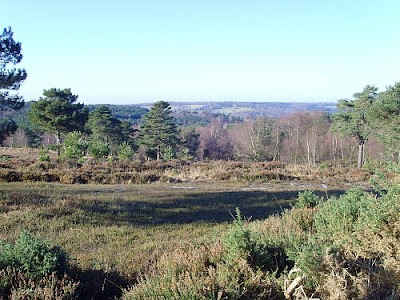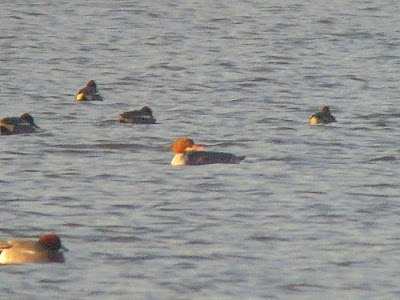
Saturday 30 January 2010
30th January 2010 Old Lodge, Weirwood, Barcombe and Arlington

Sunday 24 January 2010
24th January 2009 Castle Water and Pannel Valley

A second-winter Caspian Gull Larus cachinnans at Castle Water,
In overcast and calm conditions whilst walking east from the hide on the north bank of Castle Water, Rye Harbour Nature Reserve, we noticed a 300-strong flock of Gulls had assembled in fields just to the north of Castle Water. As they contained a good number of Herring Gulls we decided they warranted a closer look. We approached to a range of c.100m and started to scrutinise the flock through our telescopes mounted on tripods.
Roughly mid-flock, DC noticed a Gull facing directly away from us with a mantle a shade darker than the accompanying adult argenteus Herring Gulls, which on that basis looked interesting. Fortunately it was stood between two red colour-ringed argenteus Herring Gulls which aided quickly directing JFC to the bird under observation.
We immediately set about ageing the bird and whilst we soon considered that its predominantly grey mantle appeared too ‘advanced’ for a second-winter Herring Gull, as its primaries appeared wholly black (lacking any white terminal spots) and its tertials were very clearly black-centred it was too immature to be a third-winter. We soon concluded that its overall plumage closely recalled that of a second-winter Yellow-legged Gull, including one seen and photographed at Pett beach in December 2008.
Despite being larger than some of the smaller argenteus Herring Gulls it was no larger than others. Whilst DC was still thinking along the lines that it would prove a second-winter Yellow-legged Gull, JFC started expressing concerns that its mantle, although a shade darker than argenteus, appeared both paler and greyer (lacking any hint of a blue hue) than he would expect of a second-winter Yellow-legged Gull. At this time the penny began to drop that it was also showing other pro-Caspian Gull features including black-centred tertials with broad neat white ‘thumb-nailed’ edgings lacking any subterminal patterning or notching and a necklace of dark spotting restricted to its lower hindneck. JFC also drew DC’s attention to its long thin legs that were clearly also a paler pink than the first- and second-winter argenteus Herring Gulls stood in the immediate vicinity. However, it was not until it stuck its head-up and turned its head side-on, when it revealed a long giraffe-like neck, a small all-white pear-shaped head, a ‘never-ending long’ white loral area, a small beady black eye placed high on its head, long gape-line and an extremely long slender bill that gave the appearance of slightly drooping towards the tip that we realised it really was showing both plumage and structural features of a ‘classic’ second-winter Caspian Gull. Close examination of the bill showed it pale-tipped, being at least two-thirds basally a dull olive-yellow, with a narrow dark sub-terminal band that slightly bled along the cutting edge towards its base. Having now watched it for around 10 minutes DC set about obtaining some record digiscoped images.
It soon turned side-on and with a noticeably vertical gait, as if on tiptoes, it walked to the right showing the full extent of its long primary projection beyond its tail-tip, being considerably longer than tertial to tail-tip, giving it a very elongated and streamlined look whilst walking, there being no hint whatsoever of a tertial step. Helpfully the bird decided to wing-stretch on several occasions revealing greyish median coverts, a contrastingly dark greater covert bar, dark secondaries, a pale inner-primary ‘window’, and JFC noticed and pointed out an obvious sub-terminal white mirror on p10 (although seen well by us both, neither of us appreciated the importance of the mirror at the time). Whilst wing-stretching and tail-twisting a white rump and a predominantly pure white tail with a neatly demarcated terminal black band were also clearly seen. The bird then again walked to the right and out of view behind other Gulls.
We decided to get closer to try and obtain better images, and had just started to again scan the flock, when an approaching dog and owner flushed the entire flock with virtually all of the Gulls flying south towards the sea.
On getting back to our car, a check of the new Collin’s Guide confirmed our ageing of the bird and reassuringly both the structural and plumage features seen were a very close match to their illustration of a second-winter Caspian Gull. Furthermore, an in-flight second-winter Caspian Gull was illustrated with a mirror towards the tip of p10, whereas Yellow-legged Gull was not, although the text did not attach any importance to this feature. On getting home it was then satisfying to read in the Gulls book that some second-winter Caspian Gulls show this character (and it is illustrated therein) and the illustration in Martin Garner’s original 1997 British Birds paper also portrays this as a unique feature of a second-winter Caspian Gull.

Plate 1. Second-winter Caspian Gull at Castle Water. Whilst the bird is partially obscured the image best shows the bird's long and slightly-kinked and bulging neck and the whiteness of its small head, and the position of its small beady eye to good effect. Furthermore its pale thin legs and pale-tipped dark greater covert bar are just discernible. It is hard to imagine that one of the surrounding argenteus Herring Gulls could stick its head up and appear anything like as long-necked as the Caspian Gull!

Plate 2. Second-winter Caspian Gull at Castle Water. In side-on profile this image best shows its pear-shaped head by virtue of its long sloping forehead and angular rear crown, 'long' loral area and its pale-tipped very long and slender olive-yellow bill. There is also the hint of the bird's long gape line.


Plate 4. Second-winter Caspian Gull at Castle Water. The distinctive 'white thumb-nailed' black-centred tertials compare favourably with illustrations of second-winter Caspian Gulls in Martin Garner's original 1997 British Birds paper, the Olsen Gulls book and the new Collin's Field Guide.
 Plate 5. Second-winter Caspian Gull at Castle Water. Whilst unfortunately horribly blurred, the image does hint at the bird's tail pattern and shows the pale colour and long length of the tibia whilst wing-stretching.
Plate 5. Second-winter Caspian Gull at Castle Water. Whilst unfortunately horribly blurred, the image does hint at the bird's tail pattern and shows the pale colour and long length of the tibia whilst wing-stretching.Saturday 23 January 2010
23rd January 2010 Arlington Reservoir, Cuckmere Haven, Ouse Project, Newhaven Harbour, Ashdown Forest





Sunday 17 January 2010
17th January 2010 Pagham Lagoon, Pagham Harbour, Chichester GPs and Selsey Bill


Saturday 16 January 2010
Thursday 14 January 2010
Wednesday 13 January 2010
Tuesday 12 January 2010
11th January 2010 Burgess Hill Still a covering of snow
Meadow Pipit 1 in very poor shape along the pavement at the top of Ferndale Road
Sunday 10 January 2010
Saturday 9 January 2010
9th January 2010 Burgess Hill
Greenfinch 20









 Fieldfare along Kingsway
Fieldfare along Kingsway +of+SNV32495.JPG)











































